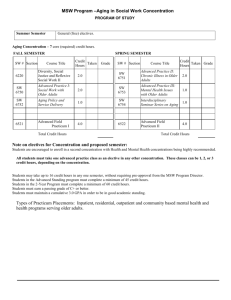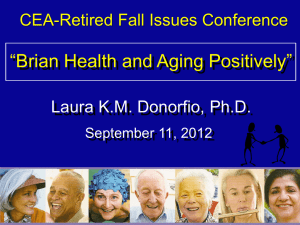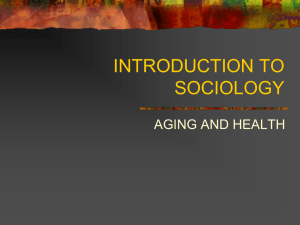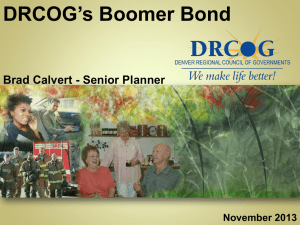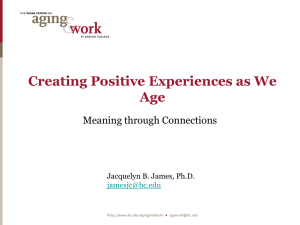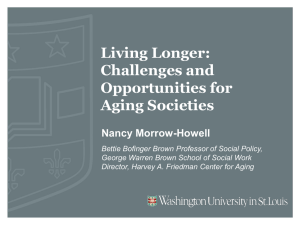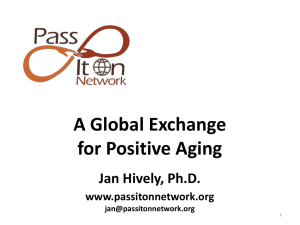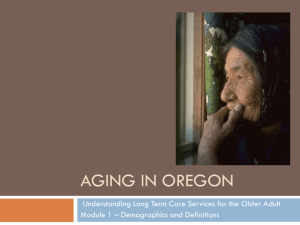Working with an Aging Population: Myths and Realities
advertisement
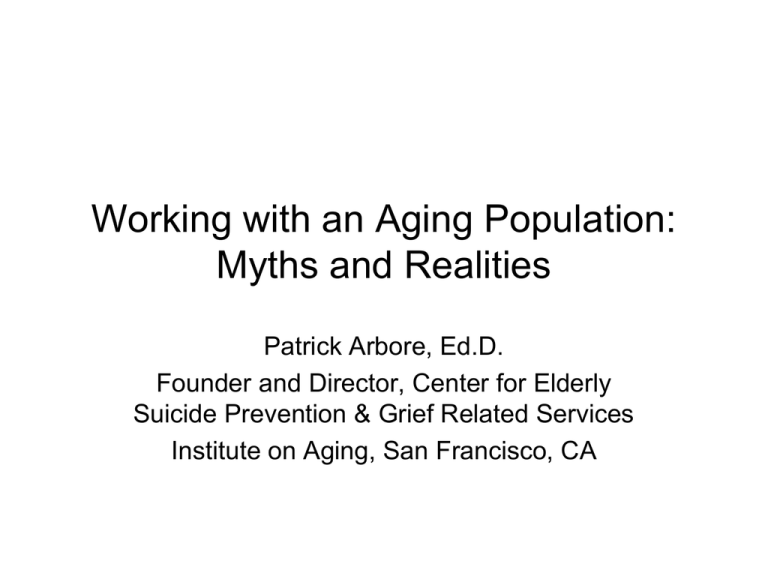
Working with an Aging Population: Myths and Realities Patrick Arbore, Ed.D. Founder and Director, Center for Elderly Suicide Prevention & Grief Related Services Institute on Aging, San Francisco, CA What is Your Aging IQ National Institute on Aging Please answer True or False: • Everyone becomes “senile” sooner or later • American families have by and large abandoned their older members • Depression is a serious problem for older people • The numbers of older people keep growing Aging IQ • The vast majority of older people are selfsufficient • Mental confusion is an inevitable, incurable consequence of old age • Intelligence declines with age • Sexual urges and activity normally cease around age 55-60 • If a person has been smoking for 30 or 50 years, it does no good to quit Aging IQ • Older people should stop exercising and rest • As you grow older, you need more vitamins and minerals to stay healthy • Only children need to be concerned about calcium for strong bones and teeth • Extremes of heat and cold can be dangerous to old people Aging IQ • Many older people are hurt in accidents that could have been prevented • More men than women survive to old age • Death from stroke and heart disease are declining • Older people on the average take more medications than younger people • Snake oil salesmen are as common today as they were on the frontier Aging IQ • Personality changes with age, just like hair color and skin texture • Sight declines with age Aging Demographics: The Reality According to the US Census Bureau 2007: • Total US population – 281,296,639 • Of these, 35.1 million were >65, making up 12.4% of the total population • About 20.5 million were older women • 14.4 million were older men Demographics • The number of older adults is expected to double within the next 25 years • By 2030 about 1 in 5 Americans (72 million people) will be >65 • The age group >85 is now the fastest growing age population • 1/3 of older people live alone; 2/3 live with or near family Demographics • Few live in skilled nursing facilities (15% of those >85 • Control 70% of total net worth in U.S. • 85+ population with Alzheimer’s Disease is close to 50% and is growing • Aging (Baby) Boomers have been turning 65 this year Denial of Aging According to Gillick (2006): “When we believe we will stay young forever, and when we purchase special vitamins, herbs, and other youth-enhancing chemicals to promote longevity, we are engaging in massive denial An Elder Speaks A woman 60 years of age states: “Strange how these things creep up on you. I really was surprised and upset when I first realized it was not the headlights on my car that were dim but only aging night vision. Then I remembered other bits of awareness that forced me to recognize that I, that 16-year-old inside me, was experiencing normal changes that go along with getting old.” Denial • Americans spend an extraordinary $6 billion annually on “anti-aging” remedies • Aging (baby) boomers and their aging cohort take pills and dietary supplements that purport to prevent illness, cure diseases and promote long life • There is overwhelming evidence that the remedies are ineffective at best, harmful at worst – and a phenomenal waste of money Covering Up Old Age • That use of hair color is so pervasive that it is hard to estimate the amount of money spent on vanquishing the gray • The mechanics of hiding age include: botox, facelifts, and liposuction to name a few surgical procedures Anti-Aging Books • The number of books that are written to prevent aging far surpass books that address coping with aging Reality of Aging • Very advanced age will be the experience for many of us • Life expectancy at age 65 is 19.2 years for American women and 15.9 years for American men (Gillick, 2006) Causes of Death for People >65 National Vital Statistics Report, 2002: • Heart Disease – 32.4% • Cancer – 21.7% • Stroke – 8.0% • Chronic lower respiratory disease – 5.9% • Influenza and pneumonia – 3.1% • Diabetes – 3.0% • Alzheimer’s disease – 3.0% • Other – 22.08% Alzheimer’s Disease According to the National Alzheimer’s Assoc (2011): • Today 5.3 million Americans have AD • Predicted that as many as 16 million Americans will have AD by 2050 – there will be 1 million new cases annually • 1 in 8 baby boomers will get AD after they turn 65 • At 85 that risk increases to 1 in 2 Ageism According to Butler: “Ageism can be seen as a process of systematic stereotyping of and discrimination against people because they are old, just as racism and sexism accomplish this with skin color and gender. Old people are categorized as senile, rigid in thought and manner, old-fashioned in morality and skills…Ageism allows the younger generations to see older people as different from themselves; thus they subtly cease to identify with their elders as human beings.” p. 12 Traditional Medical Continuum • • • • • • • Absence of Disease/Illness Presence of condition Seeking treatment Restricted activity Major restricted activity Institutionalization Illness and death Implications for the Older Person Traditional Model • The expectation is that treatment will be sought when an individual develops a condition • At this point the individual begins the descent into dependency and despondency either temporarily or longterm • The role of the individual is more passive than active Implications for those Who Care for Older People • A conviction by professional helpers that older people are individuals with declining health generates the following response: Older people are ill and feeble or potentially so • To reverse conditions or institute preventive health measures are useless for older people What is the Right Approach to Medical Care for Older Adults? • Instead of exploring these questions, we choose instead to engage in collective denial of aging • Prefer to believe that most people can skip old age altogether – proceed from middle age to death (60 is the new 40) • Put out faith in exercise and diet as a means of assuring a vigorous old age Preventing Chronic Disease Through Diet and Exercise • Many of the problems of older age cannot be prevented through diet and exercise • If we assume that diet and exercise prevents chronic disease, we will fail to take seriously the need for a radical new model of medical care – to care for people with chronic illness Drugs to Make Us Immortal • If we put our faith in anti-aging drugs, we will neglect to fund research into conditions such as macular degeneration (the leading cause of visual impairment in older adults) and osteoarthritis (the number one medical problem in the elderly and a major source of pain and immobility) • These disorders impair the quality of life for millions of older people Health and Wellness According to Pender and colleagues (2002): Health may be define as “the actualization of inherent and acquired human potential through satisfactory relationships with others, goal-directed behavior and competent personal care while adjustment are made as needed to maintain stability and structural integrity.” Multiple Dimensions of Health • Health can be seen as a more expansive phenomenon with multiple dimensions: biopsychosocial, spiritual, environmental, and cultural • A change in any of those dimensions affects the health of an individual in a positive or negative manner • A behavioral change can lead to empowerment Empowerment • May open many other options for improving one’s health • A positive approach to health emphasizes: strengths, resilience, resources, and capabilities rather than existing pathology The Wellness Model • Well-being • Self-actualizing • Growth • Education No Discernable Diseases • Signs of disease • Symptoms • Disability • Premature Death The Wellness Approach • This approach suggests that every person has an optimum level of functioning for each position on the wellness continuum to achieve a good and satisfactory existence • Even in chronic illness and dying, an optimum level of wellness and well-being is attainable for each individual Achieving Wellness • Wellness is a balance between one’s environment, internal and external, and one’s emotional, spiritual, social, cultural, and physical processes Chronic Diseases • The most prevalent chronic conditions in people >75 are much more common in women • Racial and ethnic differences in health status continue with the leading causes of death and disability dramatically higher among racial and ethnically diverse populations Key Strategies for Improving the Health of Older People • Healthy Lifestyle Behavior • Injury prevention • Diversity of culturally appropriate clinical preventive services • Immunization and preventive screenings • Management techniques for those with chronic illnesses Adapted from Generations (2005) Older Adults and Self-Efficacy • Self-efficacy implies control and places one’s wellness in one’s own hands • Often older people place the responsibility for their health in the hands of physicians and nurses • We need to change older people’s expectations of physicians, particularly in the are of health prevention and health maintenance Treat People in Accordance with Geriatric Principles • Recognize the variety of health statuses among the elderly • People with dementia, for example, need assistance with IADL’s and ADL’s – some of these individuals are both frail and experience features of dementia • People have different pain thresholds, as well as varying tolerance for discomfort or uncertainty or disability Other Changes • Medicare must be overhauled in order to meet the needs of those with chronic illness • Nursing homes (which house 1.6 million people) and which will continue to provide care for the neediest and most disabled older people have to be transformed from institutions into homes References Butler, R. (1975). Why survive? Being Old in America. Baltimore: The Johns Hopkins University Press. Gillick, M. (2006). The denial of aging: Perpetual youth, eternal youth and other dangerous fantasies. London: The Harvard University Press. References Ebersole, P., Hess, P., et al. (2008). Toward healthy aging (7th ed.). St. Louis: Mosby Alzheimer’s Association (2011). Generation alzheimer’s: The defining disease of the baby boomers. Yallom, I. (2008). Staring at the sun: Overcoming the terror of death. San Francisco: Jossey-Bass
